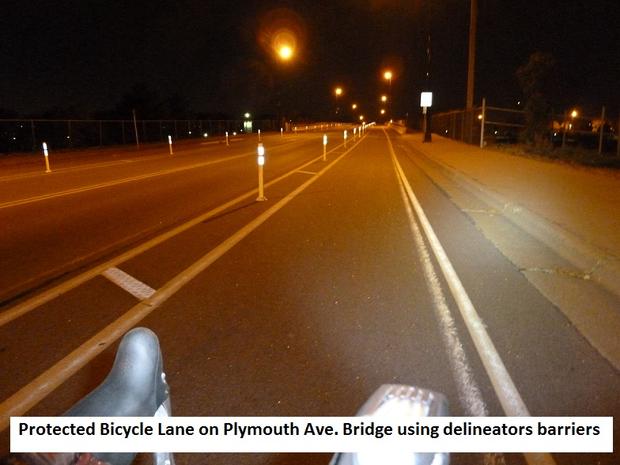Guy On A Bike: Are Protected Bike Lanes Safer?
A stretch of protected cycling lane recently opened on 36th St. W. in Minneapolis, spanning from Lake Calhoun to Bryant Ave S. (A protected lane is an on-street bicycle lane that is separated from automobile traffic by some sort of barrier. These can include a wall, delineators, parked cars or a boulevard.) The opening of this lane opened got me wondering: Are protected lanes really safer for cyclists?
Keep in mind that protected lanes are wholly different than a bike path or trail. Paths and trails are completely separate from roadways, although a user may be required to cross streets at times. Protected bicycle lanes, which I will focus on, are typically created by removing a lane of auto traffic, so cars and bikes still share the same surface, albeit separated by a barrier. (The attached pictures should help to clarify.)
Anecdotally, I feel that protected bike lanes could prove to be more dangerous. For one, the amount of space a cyclist has to maneuver around impediments or hazards is reduced. When cycling down a conventional roadway I rarely feel endangered by the auto traffic traveling alongside me. (In fact, I worry more about drivers in parked cars opening their doors right in my path.) Intersections seem to be the most dangerous spot for interactions between motorists and cyclists…and data backs me up on that. Two of the most common reasons for automobile vs. bicycle collisions are "failure to yield right of way" and "disregard of a traffic control device," according to a MN Department of Public Safety report on 2012 crashes. Both of these scenarios play out at intersections, and both cyclists and drivers are culpable. When bikes and motorists are separated by artificial barriers, as with protected lanes, they are less likely to be aware of one another, leading to a greater risk of a collision where interaction between the two is necessary. I almost experienced this firsthand on a recent ride.
While researching this blog I took a spin down 1st Ave in downtown Minneapolis, where parked cars separate auto traffic from the protected bike lane. In theory this makes riding safer and gives cyclist a dedicated lane. In reality, I saw a semi-truck parked in the clearly-marked cycling lane, causing me to ride into traffic. And just before that I almost slammed into an SUV that turned right in front of me at a green light where I was going straight and had the right of way. I think the parked cars between us prevented him from seeing me coming up on his right. I observed a bike messenger that avoided the cycling lane altogether and rode his bike amongst the autos in the middle of the street.
Simon Blenski, Bicycle Planner for the city of Minneapolis, explained "research shows that protected bike lanes have a high degree of perceived safety [emphasis added] among the public." Essentially, cyclists feel safer in protected bike lanes. There is little research on whether protected lanes are actually safer, although a 2011 memo from the city of New York indicates that, where there are protected lanes, crashes for all road users "typically drop by 40 percent and by more than 50 percent in some locations." Blenski also noted that intersections can pose challenges for cyclists in protected bike lanes and "additional signing, pavement markings, or special signalization" may be added if deemed necessary.
The city's 2013 Climate Action Plan has a goal of adding 30 miles of on-street protected bike lanes by 2020. I am all for this, if it encourages more people to ride bicycles. But I urge planners to look at best practices when implementing new protected lanes. While I'm not a fan of stretches like that on 1st Avenue, I think protected bike lanes can be a valuable part of the bicycle system infrastructure. I like the delineator barrier style lanes (pictured), similar to the new lane on 36th Street. While there is a barrier between motorists and cyclists, each is able to keep the other in full view the entire time, hopefully leading to a greater awareness and fewer problems at intersections.
Future projects for protected bike lanes in Minneapolis have been approved and funded on Washington Ave S. (from Hennepin to 5th Ave. S.), on the Franklin Ave. bridge over the Mississippi River, and along corridors on 26th and 28th streets.





